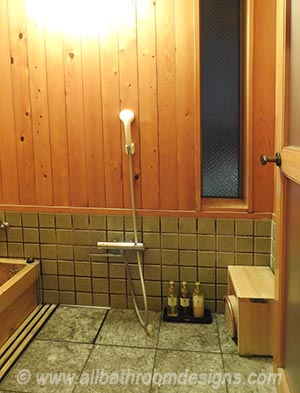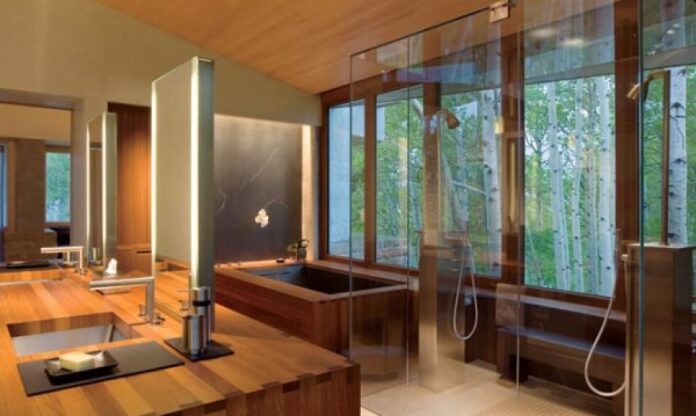Japanese bathrooms are designed to be as efficient and practical as possible. This means that they are usually small, with just enough space for a person to use the toilet and shower. The walls and floors are often made of waterproof materials such as tile or stone, which makes them easy to clean.
Japanese toilets are also typically very high-tech, with features such as heated seats and automatic flushing.
Bathrooms in Japan are typically small, with limited space for storage. This can be a challenge when it comes to design, but there are ways to work around it. One way is to use vertical storage solutions, like shelves or cabinets that go all the way up to the ceiling.
Another option is to use multipurpose furniture, like a dresser that can also be used as a linen closet.
Japanese bathroom design also tends to focus on simplicity and functionality. There is often an emphasis on clean lines and minimal decoration.
This doesn’t mean that bathrooms have to be boring, though – you can still add your own personal touch with things like art or photos.
If you’re looking for some inspiration for your own Japanese-inspired bathroom, check out these ideas!

Credit: www.allbathroomdesigns.com
What is a Japanese Style Bathroom?
A Japanese style bathroom is a type of bathroom that is common in Japan. These bathrooms typically have a small shower area, a sink and a toilet. The walls are often tiled or made of stone, and the floors are usually made of tile or linoleum.
Japanese style bathrooms often have a window to allow natural light into the room, and they may also have a sliding door to save space.
How Do Japanese Build Their Bathrooms?
Japanese bathrooms are typically small, with only enough space for a shower or bath, sink and toilet. This can make them seem cramped, but Japanese homeowners have found ways to maximize their space.
One way they do this is by using compact fixtures.
For example, toilets in Japan are often wall-mounted so that they take up less space. Sinks are also often small and rectangular to fit in tight spaces.
Another way Japanese homeowners make the most of their bathroom space is by using storage efficiently.
Shelves and cabinets are often built into the walls to store towels, toiletries and other items out of sight.
Japanese bathrooms may be small, but they are well-designed to make the most of the available space. With careful planning and thoughtful fixtures, these rooms can be both functional and stylish.
Why are Japanese Toilets Separated?
It’s no secret that Japan is a country with some pretty unique customs and traditions. From their love of all things cute and kawaii, to their incredibly intricate cuisine, there’s just so much about Japanese culture that sets it apart from the rest of the world. Even their toilets are different!
In most western countries, toilets are typically joined together in a single unit. But in Japan, it’s not uncommon to see toilets separated into two distinct sections: a urinal area for men, and a stall area for women. So why is this?
There are actually quite a few reasons behind the separation of Japanese toilets. For one thing, it helps to cut down on lineups at public restrooms (since men can use the urinals without having to wait for an empty stall). It also makes things more convenient for those who need assistance using the toilet, as there are usually attendants on hand to help out in both the male and female sections.
And lastly, it just seems to be cleaner overall – since there aren’t any shared surfaces between users, there’s less of a chance for germs to spread.
So next time you’re in Japan and you see those signs pointing you towards the correct toilet section, don’t be confused – just know that there’s a method to this madness!
Why are Japanese Bathrooms on the Floor?
This is a question that we get a lot, and it definitely has an interesting answer! Japanese bathrooms are typically on the floor for a few reasons. The first reason is that it is more comfortable to sit on the floor than it is to sit on a raised toilet seat.
This is because in Japan, people typically wear shoes inside the house, so they are used to sitting on the floor. Additionally, sitting on the floor allows for better elimination when going to the bathroom.
Another reason that Japanese bathrooms are often on the floor is because of space constraints.
In many houses and apartments in Japan, there simply isn’t enough space for a traditional Western-style bathroom with a toilet, sink and shower all in one room. So, by putting the toilet on the floor, it frees up space for other things like a shower or bathtub.
Lastly, some people believe that having a bathroom on the floor makes it easier to clean.
Since everything is already at ground level, there’s no need to worry about cleaning hard-to-reach places.
39+ Japandi Bathroom Ideas
Japanese Bathroom Design Uk
There are a lot of different ways that people can design their bathrooms. Some people like to keep things simple, while others like to go all out and make a statement. When it comes to Japanese bathroom design, there are a few key elements that you should keep in mind.
First, remember that simplicity is key. This doesn’t mean that your bathroom needs to be boring, but you shouldn’t try to cram too much into the space. Keep the fixtures and fittings clean and sleek, and opt for muted colors instead of bright ones.
Second, think about the layout of the room carefully. The traditional Japanese way is to have a small bathtub in one corner, with a sink and toilet in another corner. However, this doesn’t always work well in Western homes where we tend to have more space.
You might want to consider having two sinks so that two people can use the bathroom at the same time, or placing the bathtub in the center of the room so that it becomes more of a focal point.
Third, don’t forget about storage! In Japan, it’s common to see toilets with built-in cabinets beneath them – this is perfect for storing toiletries and keeping the bathroom looking tidy.
If your home doesn’t have enough space for built-in storage, look for other ways to keep things organized such as using baskets or hooks on the walls.
By following these simple tips, you can create a beautiful Japanese-inspired bathroom in your own home!
Conclusion
Bathrooms in Japan are often small, but that doesn’t mean they can’t be stylish and functional. Japanese bathroom design often focuses on simplicity and nature-inspired elements. This can be seen in the use of natural materials like wood and stone, as well as in the incorporation of plants into the space.
The focus on simplicity also extends to the layout of Japanese bathrooms, which tend to be clean and uncluttered. In addition to being stylish, Japanese bathrooms are also designed with function in mind. For example, many feature built-in showers and baths, as well as storage solutions that make the most of the limited space.
Related Post:


